
In the fields of horticulture and botany, the term deciduous means "falling off at maturity" and "tending to fall off", in reference to trees and shrubs that seasonally shed leaves, usually in the autumn; to the shedding of petals, after flowering; and to the shedding of ripe fruit. The antonym of deciduous in the botanical sense is evergreen.

The Oleaceae are a family of flowering plants in the order Lamiales. It presently comprises 28 genera, one of which is recently extinct. The extant genera includes Cartrema, which was resurrected in 2012. The number of species in the Oleaceae is variously estimated in a wide range around 700. The Oleaceae consist of shrubs, trees, and a few lianas. The flowers are often numerous and highly odoriferous. The family has a subcosmopolitan distribution, ranging from the subarctic to the southernmost parts of Africa, Australia, and South America. Notable members of the Oleaceae include olive, ash, jasmine, and several popular ornamental plants including privet, forsythia, fringetrees, and lilac.

Amelanchier, also known as shadbush, shadwood or shadblow, serviceberry or sarvisberry, juneberry, saskatoon, sugarplum, wild-plum or chuckley pear, is a genus of about 20 species of deciduous-leaved shrubs and small trees in the rose family (Rosaceae).

Lagerstroemia, commonly known as crape myrtle, is a genus of around 50 species of deciduous and evergreen trees and shrubs native to the Indian subcontinent, southeast Asia, northern Australia, and parts of Oceania, cultivated in warmer climates around the world. It is a member of the family Lythraceae, which are also known as the loosestrife family. The genus is named after the Swedish merchant Magnus von Lagerström, a director of the Swedish East India Company who supplied Carl Linnaeus with plants he collected. These flowering trees are beautifully colored and are often planted both privately and commercially as ornamentals.
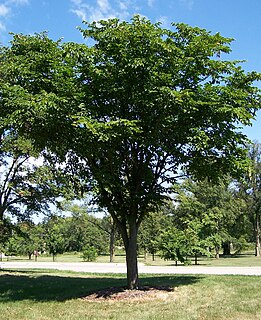
The Ulmaceae are a family of flowering plant that includes the elms, and the zelkovas. Members of the family are widely distributed throughout the north temperate zone, and have a scattered distribution elsewhere except for Australasia.

Magnolia virginiana, most commonly known as sweetbay magnolia, or merely sweetbay, is a member of the magnolia family, Magnoliaceae. It was the first magnolia to be scientifically described under modern rules of botanical nomenclature, and is the type species of the genus Magnolia; as Magnolia is also the type genus of all flowering plants (magnoliophytes), this species in a sense typifies all flowering plants.
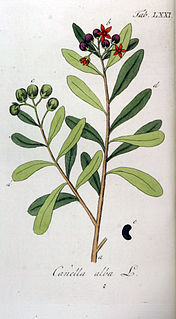
The Canellaceae are a family of flowering plants in the order Canellales. The order includes only one other family, the Winteraceae. Canellaceae is native to the Afrotropical and Neotropical realms. They are small to medium trees, rarely shrubs, evergreen and aromatic. The flowers and fruit are often red.

Theaceae, the tea family, is a family of flowering plants comprising shrubs and trees, including the economically important tea plant, and the ornamental camellias. It can be described as having from seven to 40 genera, depending on the source and the method of circumscription used. The family Ternstroemiaceae has been included within Theaceae; however, the APG III system of 2009 places it instead in Pentaphylacaceae. Most but not all species are native to China and East Asia.

Gordonia is a genus of flowering plants in the family Theaceae, related to Franklinia, Camellia and Stewartia. Of the roughly 40 species, all but two are native to southeast Asia in southern China, Taiwan and Indochina. The remaining species, G. lasianthus (Loblolly-bay), is native to southeast North America, from Virginia south to Florida and west to Louisiana; G. fruticosa is native to the tropical rainforests of Central and South America, from Costa Rica to Brazil.

Myrica is a genus of about 35–50 species of small trees and shrubs in the family Myricaceae, order Fagales. The genus has a wide distribution, including Africa, Asia, Europe, North America and South America, and missing only from Australia. Some botanists split the genus into two genera on the basis of the catkin and fruit structure, restricting Myrica to a few species, and treating the others in Morella.
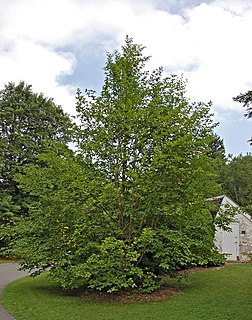
Stewartia pseudocamellia, also known as Korean stewartia, Japanese stewartia, or deciduous camellia, is a species of flowering plant in the family Theaceae, native to Japan and Korea.

Vitex is a genus of flowering plants in the family Lamiaceae. It has about 250 species. Common names include "chaste tree" or "chastetree", traditionally referring to V. agnus-castus but often applied to other species as well.
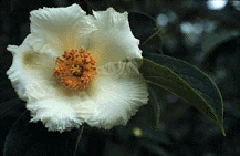
Stewartia ovata, known commonly as mountain camellia, is a small tree native to low to mid-elevations in the southern Appalachian Mountains and nearby regions from Mississippi to Virginia. It is a member of the Theaceae, the tea family.
Pentaphylax is a genus of flowering plants, with one or two species which are shrubs and small trees. The species has simple evergreen leaves that are alternately arranged on the stems. The flower pistil is 5 celled and the anthers dehiscing via pores and basifixed. Flowers have five petals and five sepals that are distinct from each other and five stamens attached oppositely to the sepals. The seeds are winged.

Stewartia malacodendron, the silky camellia, silky stewartia or Virginia stewartia, is a species of flowering plant in the family Theaceae. It grows slowly into a large deciduous shrub or small tree, typically 3–4.5 m (10–15 ft) tall, but sometimes as tall as 9 m (30 ft). It is native to the southeastern United States.

Regelia is a genus of flowering plants in the family Myrtaceae and is endemic to the south-west of Western Australia. The genus is composed of five species of small leaved, evergreen shrubs which have heads of flowers on the ends of branches which continue to grow after flowering. Another species, previously known as Regelia punicea and which is endemic to Kakadu National Park in the Northern Territory, has been transferred to Melaleuca punicea.
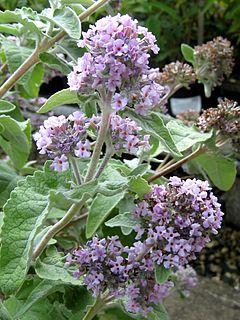
Buddleja crispa, sometimes called the Himalayan butterfly bush, is native to Afghanistan, Bhutan, North India, Nepal, Pakistan and China, where it grows on dry river beds, slopes with boulders, exposed cliffs, and in thickets, at elevations of 1400–4300 m. Named by Bentham in 1835, B. crispa was introduced to cultivation in 1850, and came to be considered one of the more attractive species within the genus; it ranked 8th out of 57 species and cultivars in a public poll organized by the Center for Applied Nursery Research (CANR) at the University of Georgia, US.. In the UK, B. crispa was accorded the Royal Horticultural Society's Award of Merit in 1961. However, the species is not entirely cold-hardy, and thus its popularity is not as ubiquitous as it might otherwise be.
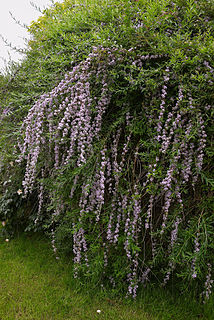
Buddleja alternifolia, known as alternate-leaved butterfly-bush, is a species of flowering plant in the figwort family, which is endemic to Gansu, China. A substantial deciduous shrub growing to 4 metres (13 ft) tall and wide, it bears grey-green leaves and graceful pendent racemes of scented lilac flowers in summer.

Stewartia sinensis is a species of flowering plant in the camellia family Theaceae, native to central and eastern China. It is typically a small deciduous tree or large shrub, commonly growing to about 9 m (30 ft) tall. It is highly regarded horticulturally for the combination of its attractive, cinnamon-colored peeling bark, numerous cup-shaped, fragrant white flowers to 10 cm (4 in) in midsummer, and generally intensely red fall foliage. The species also has an attractive multiply-branched growth habit and low maintenance requirements.



















